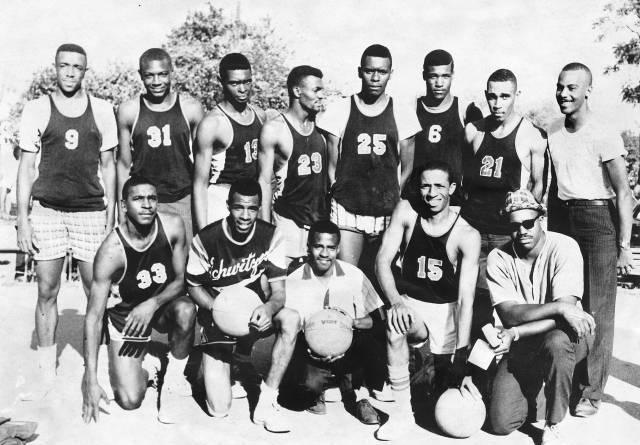The Dust Bowl Tournament emerged from a (PAL) sponsored basketball league at the , a segregated WPA Black housing community that opened in February 1938 on Indianapolis’ near west side. The original dust bowl referred to a dirt court, composed of cinder and gravel, that sat on Colton Street at the south end of Lockefield. The court was bookended by two backboards with net-less rims. The dust bowl was a popular after-school spot for many young African American basketball players from the area.

Lockefield Gardens resident Anthony Watkins started neighborhood basketball and football leagues at the dust bowl in 1940. By April 1944, Watkins became an officer. He then directed the Lockefield PAL. Officer James “Bruiser” Gaines of the PAL took over the program and built on Watkins’ recreational model. , later the coach of the mid-1950s basketball state champions, was a good friend of Gaines and joined him in his efforts. Crowe taught at segregated Indianapolis Public School No. 17, located at the corner of 11th and West streets, which lacked after-school recreational activities. As part of Lockefield PAL, Crowe’s intramural programs filled this gap for youth by providing training in basketball skills, sportsmanship, and teamwork.
The first annual basketball tournament for male graduates of Indiana high schools took place at the Lockefield court in 1948. It served as the culmination of Lockefield PAL programming in the sport. Twenty teams participated. Though its surface was paved when it took place, the “dust bowl” name stuck. The Dust Bowl Tournament became an annual event in August and quickly gained notoriety, drawing thousands of spectators, including college scouts and coaches, to watch the best players from the Midwest.

Many of the best players on Crowe’s Attucks basketball teams of the 1950s got their start in Crowe’s intramural program and played in the tournament. , Hallie Bryant, and Oscar Robertson learned the rules of the game on Crowe’s watch. Gardner played in the 1953 tournament and gained fame as a Harlem Globetrotter before having his career cut short by a heart ailment. Another Attucks standout, Bryant played in the 1953 tournament before finding success in the NBA. Robertson played on Attucks’ 1955 championship team and then the 1955 Dust Bowl Tournament before he later landed a career in the NBA.
In 1954, Indiana University asked the Indianapolis Redevelopment Commission to declare a 15-acre tract of land in Lockefield Gardens blighted in order to purchase it, demolish the structures on the land, and expand the . As the neighborhood lost residents with the creation of the campus, the Dust Bowl Tournament left the area, hosting its last Dust Bowl Tournament in August 1974.
(IBE) took over sponsorship of the Dust Bowl Tournament making it part of its Soul Picnic event from 1975 to 1998. Tarkington Park hosted the first IBE-sponsored event in 1975. Washington High School graduate and future NBA star George McGinnis played that year. Other city parks, including Douglass Park, Watkins Park, and Washington Park have been the site of the tournament. From 1983 to 1986, the event was known as the George McGinnis Dust Bowl tournament, and a junior division for boys and girls was added in 1984.
After two safety issues arose at IBE’s Soul Picnic in 1993 and 1998, IBE rebranded its event Soul Fest in 1999, with continued sponsorship of the Dust Bowl Tournament. But crowds at the IBE event continued to outpace the city’s ability to ensure safety, which led to the indefinite hiatus of the Dust Bowl Tournament in 2000.

A decade later, in 2010, IBE resurrected its summer festival. Now called The Family Reunion, the Dust Bowl Tournament became one of IBE’s feature attractions, played at Washington Park.
In February 2016, the site of the dust bowl basketball court was recognized with a historical marker at the corner of Blake and North streets on the IUPUI campus. The area has been redeveloped as a park with three basketball courts.

Help improve this entry
Contribute information, offer corrections, suggest images.
You can also recommend new entries related to this topic.

